Oral
Acquisition, Reconstruction & Analysis
Tuesday, 25 April 2017
| Room 316BC |
13:45 - 15:45 |
Moderators: Markus Barth, William Grissom |
Slack Channel: #s_acq_recon_analysis
Session Number: O60
13:45
 |
0515.
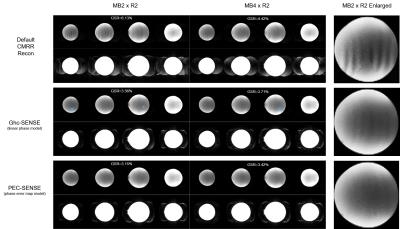 |
Robust 2D Nyquist Ghost Correction for Simultaneous Multislice (SMS) EPI Using Phase Error Correction SENSE and Virtual Coil SAKE 
Mengye Lyu, Markus Barth, Victor Xie, Yilong Liu, Yanqiu Feng, Ed Wu
Nyquist ghost is problematic in SMS EPI because the ghost is slice-dependent and can interfere with slice separation process. The inconsistency between positive and negative echoes can be represented by 2D phase error maps. This study presents a new and robust SENSE-based method. It estimates both phase error maps and coil sensitivities from one plain EPI based calibration scan, and then uses these maps for ghost-free SMS EPI reconstruction. Further, to improve coil sensitivity estimation, virtual coil SAKE is incorporated to reduce the high order Nyquist ghost in the calibration scan.
|
13:57
 |
0516.
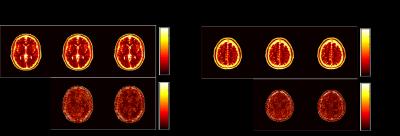 |
A Maximum Likelihood Approach to Simultaneous Multislice Magnetic Resonance Fingerprinting - permission withheld
Bo Zhao, Berkin Bilgic, Jason Stockmann, Lawrence Wald, Kawin Setsompop
Magnetic resonance fingerprinting is an efficient quantitative MRI paradigm, which simultaneously acquires multiple MR tissue parameters. Recently, simultaneous multislice (SMS) acquisition has been used to further speed up MRF experiments. In this abstract, we present a maximum likelihood formulation to enable improved SMS-MRF reconstruction. We further describe an algorithm based on variable splitting, the alternating direction method of multipliers, and the variable projection method to solve the resulting nonlinear and nonconvex optimization problem. Representative results are shown to demonstrate that the proposed method enables more accurate MR tissue parameter maps compared to the recent SMS-MRF approach utilizing direct pattern matching.
|
14:09
 |
0517.
 |
Simultaneous Multi Slice Imaging using Matrix Gradient Coils 
Sebastian Littin, Kawin Setsompop, Feng Jia, Huijun Yu, Stefan Kroboth, Maxim Zaitsev
Novel SMS techniques become possible by applying specially designed spatial encoding magnetic fields (SEMs) during RF excitation or read out. Two new methods have been implemented using a matrix gradient coil.
|
14:21
|
0518.
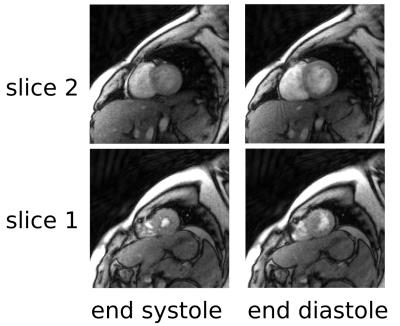 |
Simultaneous Multi-Slice Real-Time Imaging with Radial Multi-Band FLASH and Nonlinear Inverse Reconstruction 
Sebastian Rosenzweig, H. Christian M. Holme, Robin Wilke, Martin Uecker
Simultaneous multi-slice (SMS) MRI allows for the acquisition of several slices at the same time. We propose a novel reconstruction technique for radial SMS MRI based on Regularized Nonlinear Inversion (NLINV). This method does not require a priori knowledge of the coil sensitivities. We present the simultaneous estimation of images and coil sensitivities of two slices of a phantom from 10-fold undersampled data. Image quality is analyzed for different sampling schemes and compared to single-slice acquisitions. Clinical relevance is demonstrated by in-vivo imaging of two slices of a human heart in real-time at a time-resolution of 30.8 ms per frame.
|
14:33
 |
0519.
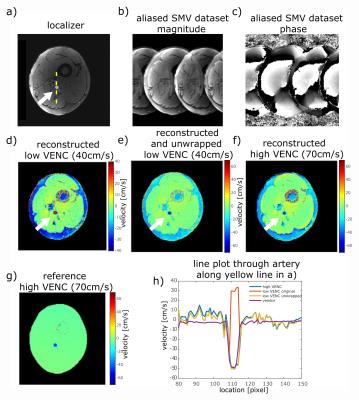 |
Simultaneous Multi-VENC Imaging 
Simon Schmidt, Sebastian Flassbeck, Mathies Breithaupt, Mark Ladd, Sebastian Schmitter
In this work we introduce and investigate the feasibility of "Simultaneous Multi-VENC" (SMV) imaging. This technique is inspired by "spokes" RF pulses used for parallel transmission and by Simultaneous-Multi-Slice (SMS) imaging. SMV enables encoding of a single 2D plane by two or more 2D phase images with different velocity sensitivities, allowing multiple encoding velocities (VENC). Only a single readout is used to acquire all VENC data, which are separated using a standard SMS slice-GRAPPA algorithm. The feasibly of SMV is demonstrated in a flow phantom and in-vivo for three spokes with two different VENC values.
|
14:45
 |
0520.
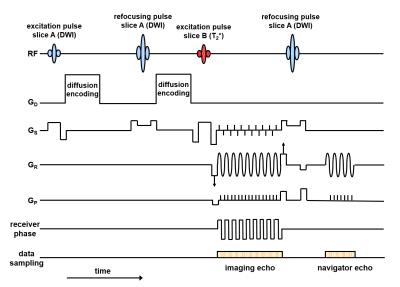 |
Simultaneous Multi-Contrast Imaging with Readout-Segmented EPI 
Nora-Josefin Breutigam, Robert Frost, Klaus Eickel, David Porter
A new method is presented for acquiring multiple image contrasts simultaneously. The technique reduces patient examination times and facilitates accurate image registration between contrasts. This work focuses on a variant of the method, in which readout-segmented EPI (rs-EPI) is used to perform high-quality, navigator-corrected, diffusion-weighted imaging simultaneously with a T2*-weighted acquisition. This combination of contrasts has clinical significance in acute stroke, providing a registered data set for assessing the infarct and possibility of associated hemorrhage. The proposed method modifies the contrast as a function of slice position and uses blipped CAIPIRINHA and slice-GRAPPA to separate the contrasts into individual images.
|
14:57
 |
0521.
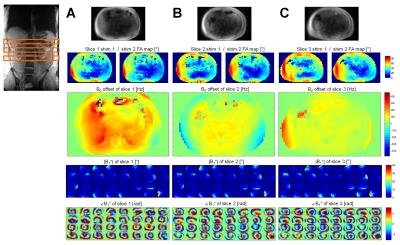 |
Fast multi-slice B1 and B0 mapping (B01TIAMO) for 32-channel pTx body MRI at 7 Tesla 
Sascha Brunheim, Sören Johst, Stephan Orzada, Jose Marques, Marcel Gratz, Mark Ladd, Harald Quick
The aim of this work was to improve the recently developed B1TIAMO method at ultra-high magnetic field for a 32-channel body transceiver array by providing complete information about both the B0 and B1+ distribution within the human abdomen without movement artifacts by breathing. Therefore, a fast multi-slice version including two-echo B0 maps with time interleaved acquisition of modes (B01TIAMO) was introduced. Furthermore, B1+ phase calculation was improved by geometric-decomposition coil compression, resulting in accurate single-channel B1+ and B0 maps for three different slices within only 21s versus the 42s step-by-step measurement for a single slice with normal B1TIAMO.
|
15:09
|
0522.
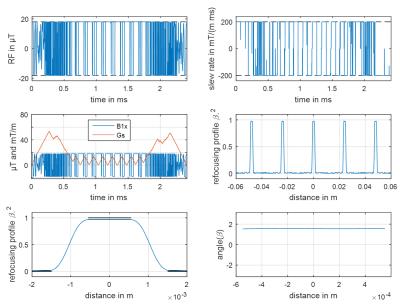 |
Simultaneous multislice refocusing by time-optimal control 
Armin Rund, Christoph Aigner, Karl Kunisch, Rudolf Stollberger
We demonstrate the design of minimum duration SMS refocusing pulses and slice selective gradient shapes with specific hardware constraints such as peak B1, peak slew rate and peak amplitude of the slice gradient. The proposed bi-level time-optimal control method works with a detailed description of the slice profile accuracy by inequality constraints, and allows the use of fine spatial and temporal grids. The optimized results are validated on a 3T scanner with phantom and in vivo measurements demonstrating the practical realizability of the presented approach.
|
15:21
|
0523.
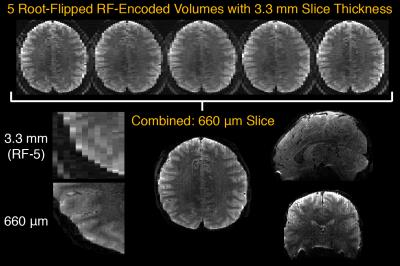 |
Minimum peak power root-flipped gSlider-SMS RF pulses for high-resolution in vivo diffusion imaging 
Jun Ma, Thomas Witzel, William Grissom, Kawin Setsompop
gSlider is an RF encoding method that increases SNR in high-resolution diffusion imaging, by repeatedly acquiring high-SNR thick-slab images with distinct through-slice RF phase encoding. The method is currently based on linear-phase RF pulses designed using the inverse scattering transform. However, the high peak power of the associated refocusing pulses requires VERSE to meet practical peak RF amplitude constraints. Here we show that the pulses can be equivalently designed using the SLR algorithm, and that the refocusing pulse can be further root-flipped to minimize its peak amplitude and obviate the use of VERSE, while preserving gSlider encoding and linear-phase spin echoes.
|
15:33
|
0524.
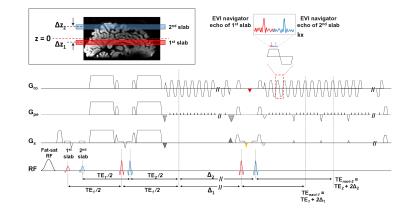 |
3D Multi-band Interleaved DW-EPI with 3D Phase Correction 
Hing-Chiu Chang, Edward S. Hui, Xiaoxi Liu, Nan-kuei Chen
The optimal SNR efficiency of 3D multi-slab multi-shot DWI acquisition can be enabled by using a TR range of 1-2s. However, due to the low feasible slab thickness, the multi-slab acquisition can only achieve limited brain coverage when using a short TR. In this study, we first develop a 3D multi-band (MB) iDW-EPI sequence with MB-EVI-based navigator to increase brain coverage when using optimal TR. Second, we extend 3D-MUSER algorithm, which is proposed in another study, to reconstruct 3D-MB-iDW-EPI data with 3D phase correction. Our preliminary result demonstrates the feasibility of 3D MB DWI with 3D phase correction.
|
|












